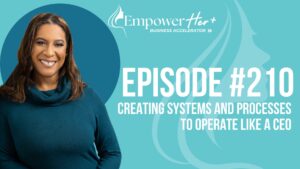From Interest to Loyalty: Mastering the Customer Journey
In the latest episode of the Empower Business Accelerator Podcast, host Philippa Channer delves into the critical stages of the customer journey: the decision and retention phases. Building on previous discussions about the awareness and consideration stages, this episode emphasizes the importance of converting interested prospects into loyal clients and maintaining those relationships post-purchase. Philippa provides actionable strategies for entrepreneurs to enhance client relationships and ensure long-term business success.
The Decision Stage
The decision stage is a pivotal moment in the customer journey. Here, potential clients weigh their options and decide whether to commit to your product or service. Philippa highlights that this stage is all about reducing friction, building confidence, and guiding prospects smoothly toward making a purchase. The content and education you’ve provided earlier in the journey come into play here, as they help establish you as a thought leader and expert in your field.
Strategies for the Decision Stage
1. Clear Call to Actions (CTAs)
- Consistency and Clarity: Ensure that your CTAs are consistent across all platforms—whether online, through social media, or in person. A clear and compelling CTA eliminates confusion and encourages prospects to take action.
- Examples: Use phrases like “Sign Up Now,” “Get Your Free Trial,” or “Schedule a Consultation” to guide potential clients on the next steps.
2. Limited Time Offers
- Creating Urgency: Limited-time discounts, bonuses, or incentives can motivate potential clients to make quicker decisions. This sense of urgency can be a powerful tool in nudging them toward committing sooner rather than later.
- Examples: Offer a 10% discount for purchases made within the next 48 hours or a free bonus item for the first 50 customers.
3. Personalized Follow-Ups
- Addressing Concerns: If a prospect shows interest but hasn’t yet made a purchase, a personalized follow-up can make a significant difference. Address any concerns they may have and offer additional support to help them feel more confident in their decision.
- Examples: Send a personalized email with a discount for enrolling within a specific timeframe, along with a testimonial from a successful client.
The Retention Stage
Once a client has made a purchase, the retention stage begins. Philippa emphasizes that this stage is crucial for maintaining the relationship and ensuring that clients continue to see value in your offerings. Retaining existing clients is not only more cost-effective than acquiring new ones, but satisfied clients are also more likely to refer others and provide repeat business.
Strategies for the Retention Stage
1. Exceptional Customer Service
- Availability and Responsiveness: Always be available to assist your clients. Address their concerns promptly and go the extra mile to ensure their satisfaction. A positive experience can significantly influence whether clients choose to stick around and refer others to your business.
- Examples: Implement a 24/7 customer support system or a dedicated account manager for high-value clients.
Regular Check-Ins
- Proactive Engagement: Don’t wait for clients to come to you with problems or questions. Be proactive in checking in with them to see how they’re doing and offer additional support or resources. This approach shows that you care about their experience and are invested in their success.
- Examples: Schedule quarterly check-in calls or send personalized emails with tips and resources relevant to their purchase.
Loyalty Programs
- Rewarding Repeat Customers: Consider implementing loyalty programs to reward repeat customers. Offering discounts, special offers, or exclusive access to new products or services can make clients feel valued and give them a reason to return.
- Examples: Offer a points-based system where clients earn points for every purchase that can be redeemed for discounts or exclusive products.
Conclusion
Philippa concludes the episode by reiterating the importance of the decision and retention stages in transforming prospects into loyal clients. By ensuring a smooth decision-making process and continuing to provide value after the sale, entrepreneurs can build lasting relationships that contribute to long-term success.
Listeners are reminded about the upcoming launch of the Empower program’s group sessions in January 2025, encouraging them to take advantage of this opportunity to connect with like-minded entrepreneurs.
Key Takeaways
- Decision Stage: Focus on clear CTAs, create urgency with limited-time offers, and personalize follow-ups to convert prospects into clients.
- Retention Stage: Provide exceptional customer service, engage in regular check-ins, and implement loyalty programs to maintain and enhance client relationships.
By mastering these stages, entrepreneurs can ensure that the real work begins after the sale, nurturing relationships and building trust to thrive in a competitive landscape.














